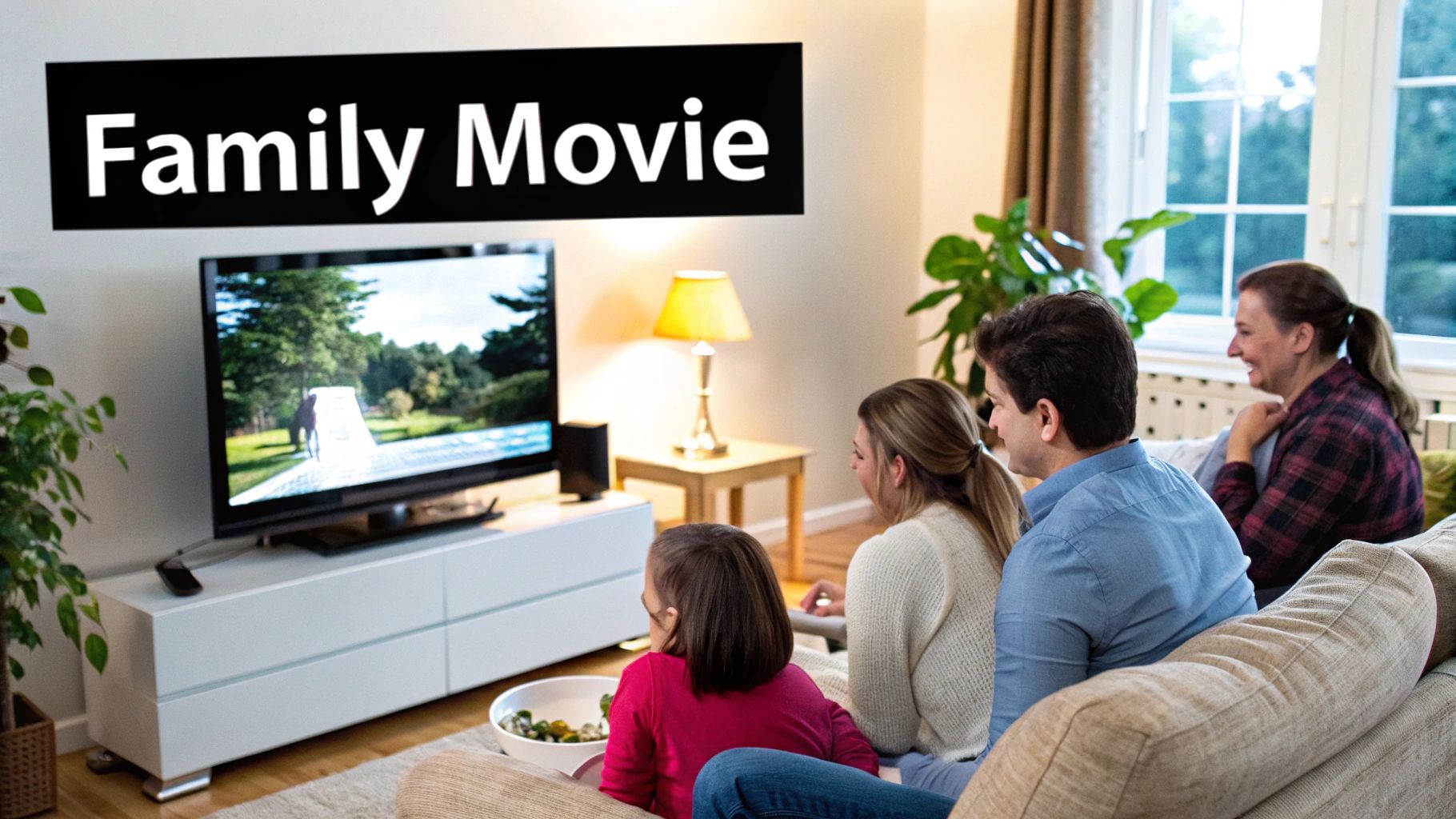
Family Sharing Netflix Guide: Cost & Setup Tips
Share
Navigating Netflix's Family Sharing Landscape

Netflix has become a household name, offering a vast selection of movies and TV shows. But understanding their family sharing policies can be tricky. Let's break down how to share your Netflix account legally and affordably.
Understanding "Household"
"Household" is central to Netflix's sharing rules. Netflix defines it as people living at the same physical address as the account owner. Sharing with people outside your home, like friends or distant family, isn't allowed under their terms of service. This is important to remember to avoid account restrictions.
Legitimate Sharing vs. Account Violations
Sharing within your household is perfectly fine. Family members living under the same roof can access Netflix from different devices. This includes parents, children, and other relatives living at the same address.
Sharing your login information with friends, even occasional visitors, is still a violation. This distinction helps clarify legitimate family sharing.
The Password-Sharing Crackdown
A major shift in Netflix's approach to sharing was the 2023 password-sharing crackdown. This aimed to monetize the over 100 million households sharing accounts without paying.
This crackdown introduced new features: setting a primary location, managing devices and access, transferring profiles, and buying extra member slots. The goal? To generate more revenue from existing users. This strategy seems to be working, with subscriber numbers hitting almost 270 million globally by early 2024. You can find more detailed stats here: An update on sharing
Netflix Family Sharing Options Comparison
To help you choose the best sharing option, let's look at a comparison table. It outlines the different ways to share your Netflix account, including standard household sharing, extra member add-ons, and separate accounts with profile transfers.
Netflix Family Sharing Options Comparison:
| Sharing Option | Cost | Number of Users | Key Limitations | Best For |
|---|---|---|---|---|
| Standard Household Sharing | Subscription Fee | Household Members | Limited to members within the defined household | Families living in the same home |
| Extra Member Add-on | Additional Fee | +1 or +2 users | Restricted to one device streaming at a time, profile restrictions | Individuals outside the household, occasional users |
| Separate Accounts | Individual Fees | Varies | No sharing restrictions, individual billing | Friends, extended family, separate households |
This table clarifies the differences in cost, user numbers, and limitations. Profile transfers are another useful feature, allowing users to move their viewing history and recommendations to a new account. This is helpful for changing family situations, like children moving out.
Crafting Your Perfect Family Streaming Setup

Sharing a Netflix account with family is a fantastic way to save money and enjoy entertainment together. But going beyond simply sharing login details can create a truly personalized experience for everyone. It all starts with understanding the features of family sharing and tailoring a setup that fits your household's unique needs.
Establishing Your Household's Primary Location
First, establish your primary location. This is essential for smooth, uninterrupted streaming. It designates the main hub for your account, ensuring everyone connected to that network enjoys seamless access. Consider it your family's streaming home base.
Creating Customized Profiles
Next, create individual profiles for each family member. This allows for personalized recommendations, separate watch lists, and a tailored experience for everyone. This prevents Dad's action movie suggestions from mixing with your daughter's animated favorites. Personalized profiles are key to maximizing everyone's enjoyment.
Implementing Parental Controls
For families with younger children, parental controls are a must. These controls restrict content based on age ratings, ensuring age-appropriate viewing. This offers parents peace of mind and allows kids to explore Netflix independently within safe boundaries. You might be interested in this helpful resource: How to master account sharing.
Managing Preferences Across Devices
Managing preferences for subtitles, audio languages, and playback settings is also important. These can be customized for each profile, allowing individual preferences across various devices, from smartphones to Smart TVs. For example, one family member might prefer subtitles, while another prefers dubbed audio.
Organizing Content Libraries
A well-organized content library can significantly improve the family streaming experience. Categorized watch lists for different genres or family members simplify browsing. This makes it easier for everyone to find what they want, regardless of their tech skills. Consider a "Family Movie Night" list or a dedicated list for documentaries.
Profile Transfers for Evolving Households
As families grow and change, so do their viewing needs. Profile transfers are invaluable when family members move out, allowing them to take their viewing history and preferences with them to a new account. This ensures a smooth transition and avoids losing years of curated recommendations.
Troubleshooting Profile Conflicts
Occasionally, conflicts can arise with shared profiles. This often happens if someone accidentally watches something on the wrong profile, affecting future recommendations. Teaching family members to use their assigned profiles helps avoid these issues. Regularly reviewing and clearing viewing history can also help maintain accurate recommendations.
Maximizing Streaming Quality
Optimizing streaming quality is crucial for an enjoyable experience. Factors like internet speed and device capabilities play a role. Choosing the right Netflix plan for your household size and internet connection ensures everyone gets the best possible picture quality without interruptions.
Hidden Netflix Features for Family Sharing
Netflix offers hidden features that can further enhance your family viewing experience. "My List" lets each profile curate a personal queue of movies and shows. The "Continue Watching" section makes it easy to pick up where you left off, even on a different device. Exploring these features can help you get the most out of your subscription and personalize it for each family member.
Extra Member Slots: The Real Value Proposition

So, you’re thinking about adding extra member slots to your Netflix subscription. But is it really worth the money? This section helps you weigh the costs and benefits of adding extra slots versus other Netflix sharing options.
Weighing The Costs: Extra Members Vs. Separate Accounts
First, understand the pricing. Extra member slots add a monthly fee to your base subscription. While convenient, compare this with the cost of separate Netflix accounts. Two extra members might cost more than a separate basic plan. This is key if someone outside your home only uses your account occasionally.
Hidden Limitations of Extra Member Slots
Netflix makes adding extra members easy, but there are limitations. Device restrictions often apply. Extra members can stream on various devices, but perhaps only one at a time.
Profile limitations exist too. Extra members usually get a single profile, making separate watch lists and personalized recommendations difficult. Geographic restrictions might also limit content based on the extra member’s location.
Real-World Scenarios and Cost Calculators
Let’s look at examples. Extra member slots might work for a family with a college student living away. But for friends sharing, separate accounts could be better. Families with different viewing habits might benefit from separate accounts or tiered plans to avoid exceeding streaming limits.
Online cost calculators can help compare scenarios. They factor in user numbers, viewing habits, and preferences to determine the best Netflix sharing approach. This personalized analysis helps make informed decisions. For more information, see these further resources on account sharing.
Understanding Netflix’s Adaptability
Netflix’s sharing policies are always changing. Despite initial concerns, their approach is proving resilient. A mid-2024 survey showed over 60% of subscribers kept their subscriptions. Most sharing happens within households. Interestingly, about 15% chose a family plan with paid extra users, showing demand for this option. You can find more information on Netflix sharing statistics. This adaptability helps Netflix keep users happy and grow revenue. It’s important to regularly assess your family’s needs and the value of extra member slots.
Profile Mastery: Personalizing Everyone's Netflix Experience

Successfully navigating family sharing on Netflix depends on effective profile management. This means more than just setting up profiles; it's about truly personalizing each family member's viewing experience for a more harmonious streaming environment.
Curating Content Algorithms for Each Family Member
Netflix uses algorithms that learn from viewing habits. Each profile's recommendations become increasingly tailored to individual tastes over time. Actively rating shows and movies helps refine these recommendations even further. This prevents recommendation corruption when profiles are occasionally shared.
Preventing Recommendation Corruption
Sharing profiles, even occasionally, can lead to conflicting recommendations. If a child briefly uses a parent's profile to watch cartoons, the parent might start seeing kids' shows in their recommendations. Encouraging consistent use of individual profiles helps mitigate this.
Regularly reviewing and clearing viewing history within each profile also maintains accurate recommendations. This ensures each profile remains truly personalized.
Organizing Watch Lists for Easy Content Discovery
Using My List effectively turns each profile into a personalized content hub. Family members can curate their own queues of movies and shows they want to watch.
This simplifies finding something to watch and makes browsing much more intuitive.
Profile Transfers: Maintaining Continuity
Profile transfers are a powerful tool, especially in evolving family situations. When a young adult moves out, they can transfer their profile to a new, independent Netflix account.
This preserves their viewing history, preferences, and curated My List, maintaining their personalized experience without starting over. This minimizes disruption and makes their Netflix experience feel exclusively theirs.
Troubleshooting Common Profile Conflicts
Even with careful management, conflicts can still happen. Someone might accidentally watch content on the wrong profile, or a shared profile becomes cluttered with differing tastes.
Implementing clear guidelines about profile usage can prevent these situations. Open communication about who is using which profile, and when, is crucial for harmonious family sharing.
Hidden Personalization Features
Netflix offers hidden features that further personalize each profile. Subtitle preferences, audio language settings, and playback speed can be adjusted individually.
This level of customization allows each family member to fine-tune their viewing experience to their exact preferences. This fosters individual ownership and ensures everyone feels their Netflix experience is truly tailored to them.
Inside Netflix's Password Sharing Changes
Netflix's shift in family sharing policies has definitely made waves in the streaming world. This change impacts both the platform and its millions of subscribers. Let's explore how these password sharing changes are influencing different households and the future of shared entertainment.
Financial Implications For Different Households
The financial consequences of Netflix's new rules are not one-size-fits-all. For multi-generational families under one roof, the change might be negligible. However, for roommates or extended families sharing an account across multiple addresses, the costs of extra member slots or separate accounts can be significant. These costs need to be weighed against the convenience of a shared subscription.
Let's take a look at how consumers have responded to these changes in the following table.
Consumer Response to Netflix Sharing Policies
Statistical breakdown of how subscribers responded to Netflix's family sharing policy changes, including subscription changes, tier selections, and demographic differences.
| Response Type | Percentage of Users | Most Common Age Group | Financial Impact |
|---|---|---|---|
| Created New Account | 35% | 25-34 | Increased Cost |
| Added Extra Members | 25% | 35-44 | Moderate Increase |
| Downgraded to Ad-Supported Tier | 15% | 18-24 | Cost Savings |
| Cancelled Subscription | 10% | All Ages | Cost Savings |
| Switched to Other Platform | 10% | 18-24 | Varies |
| No Change | 5% | 45+ | No Change |
This table is a hypothetical representation of potential consumer responses based on industry trends and publicly available information. It does not reflect official Netflix data.
Key observations from this data reveal that the largest portion of users opted to create a new account or add extra members. A noticeable number also moved to the ad-supported tier, suggesting a price sensitivity within a specific demographic.
Demographic Responses And Emerging Subscription Patterns
Different demographic groups have reacted differently to Netflix's sharing restrictions. Some have adapted, paying for additional members or starting new accounts. Others have explored alternative streaming services like Hulu or Amazon Prime Video, or continued account sharing on other platforms. These evolving subscription patterns offer insights into consumer behavior and the diverse ways people are navigating online entertainment.
Comparing Netflix With Other Streaming Platforms
Netflix's approach to family sharing isn't unique. Other major platforms, like Disney+, are implementing similar policies. This indicates a broader industry trend towards monetizing shared accounts and controlling access. Comparing Netflix's strategy with its competitors gives us a broader understanding of how family sharing is evolving across the streaming industry. You might be interested in: More articles about family sharing on Netflix.
Consumer Sentiment and Market Analysis
Consumer sentiment toward Netflix's policy changes has been a mixed bag. Initial backlash and cancellation threats were common. However, Netflix reported a significant subscriber surge, adding over 9 million new subscribers in the first quarter of 2024—five times more than the same period in 2023. This growth has been linked to the transition from shared to paid accounts, with many choosing the ad-supported tier. Find more detailed statistics here: Netflix Subscriber Surge. This indicates a shift in consumer behavior, with many accepting the new rules.
The Future Of Shared Entertainment Experiences
Netflix's password sharing changes mark a significant moment in the evolution of streaming. It prompts questions about the future of shared entertainment. As platforms balance profitability and user satisfaction, we can expect to see continued innovation in subscription models and account management. The long-term effects on consumer behavior and the streaming industry remain to be seen.
Creative Alternatives to Standard Family Sharing
Netflix's family sharing policies, while intended for traditional families, can present hurdles for those with more diverse living arrangements. This means families dealing with situations like college students living off-campus, separated parents sharing custody, or extended family members often find the standard model doesn't quite fit. Thankfully, creative solutions are available. Let's explore some alternatives to the typical Netflix family sharing setup.
Evaluating Multiple Individual Accounts vs. Family Sharing
Sometimes, the standard family sharing plan isn't the most economical choice, even though it's designed to be. Maintaining several individual basic accounts could actually be less expensive than a premium family plan, especially if viewing habits are minimal. This is particularly relevant for families where members have distinct viewing preferences. Plus, individual accounts provide more personalized recommendations and control over profiles.
Exploring Bundle Deals and Tiered Subscriptions
Consider exploring bundled service packages. Many telecommunication companies offer deals that combine Netflix with other services, such as internet or mobile phone plans. These bundles often result in considerable savings compared to individual subscriptions. For example, some mobile providers include a complimentary Netflix basic plan with specific data packages. Additionally, carefully evaluating the various Netflix tiers—Basic, Standard, and Premium—is crucial for balancing cost and usage. If 4K resolution isn't essential, a lower tier might suffice, allowing you to allocate funds to other entertainment sources. The rise of streaming has been fueled by platforms like TikTok.
Practical Solutions for Special Situations
Families with unique circumstances need adaptable solutions. For college students living away from home, periodically rotating login credentials with family members at the primary residence could be an option, remaining within Netflix's terms of service. For separated parents, alternating billing responsibility for a single shared account, connected to the child's main residence, can ensure consistent viewing access. Extended families could contribute a small monthly sum to the primary account holder, offsetting costs and fostering a shared viewing environment.
Respecting Terms of Service and Maintaining Viewing Continuity
When exploring these options, adhering to Netflix's terms of service is paramount. Open communication and collaborative solutions within families are key. Understanding device limitations, simultaneous streaming restrictions, and geographical boundaries helps avoid account issues. This proactive approach guarantees uninterrupted viewing while navigating the complexities of Netflix family sharing in a way that respects the rules. This mindful strategy can build a sustainable, enjoyable, and budget-friendly family sharing arrangement.
Unlocking Hidden Value in Your Netflix Subscription
Netflix offers more than just a massive library of movies and TV shows. It provides tools and features to optimize your family's viewing experience and get the most out of your subscription. By exploring beyond the basics, you can unlock hidden potential and tailor Netflix to each family member's individual needs.
Optimizing Streaming Quality
One of the biggest frustrations with any streaming service is buffering and poor video quality. Netflix offers options for managing your streaming quality that are often overlooked. Within your account settings, you can adjust playback settings to optimize for your internet speed and device capabilities.
This allows you to find a balance between data usage and video quality, ensuring smooth streaming even during peak internet traffic. Think of it like adjusting the water pressure in your shower, finding the sweet spot between a powerful stream and water conservation.
Mastering Downloads for Offline Viewing
For families who are always on the move, managing downloads is crucial. Netflix allows downloading content for offline viewing, perfect for long car rides or plane trips. However, download limits and expiration dates can sometimes be a challenge.
By understanding these limitations and actively managing your downloaded content, you can make sure everyone has entertainment, even without internet access. It's like packing snacks for a road trip – planning ahead keeps everyone happy and prevents unexpected boredom.
Taming the "Continue Watching" List
The "Continue Watching" feature can be a mixed blessing. While convenient for individual viewing, it can quickly become cluttered on a shared family account. Teaching family members to actively manage their "Continue Watching" list by removing finished shows or movies prevents confusion.
This also makes it simpler for everyone to find what they actually want to watch. It's like cleaning out the refrigerator – removing old items makes room for new ones and keeps everything organized.
Leveraging Recommendations for Family Harmony
Netflix’s recommendation algorithm is a helpful tool for discovering new content. However, with multiple users on a single account, recommendations can become less effective. By ensuring each family member uses their own profile, the algorithm can learn individual preferences.
This leads to more accurate and relevant suggestions. Think of it like having separate grocery lists for each family member – everyone gets what they want, and there are no surprises at checkout.
Looking Ahead: The Future of Family Sharing on Netflix
The world of streaming is constantly evolving. Netflix's family sharing policies, influenced by market trends and competitor actions, are likely to continue changing. By staying informed about these changes, you can anticipate new features and adapt your family’s Netflix strategy accordingly. This proactive approach helps you get the most out of your subscription as family sharing options on Netflix develop.
Are you looking for an even better way to manage and optimize your family’s shared subscriptions? Check out AccountShare to explore a new approach to group purchasing and access management. It's a convenient way to share premium accounts with your family, securely and easily.
